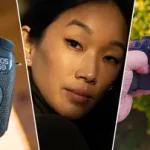Hi guys. Today we’re going to compare two surprisingly good Canon cameras in the lower midrange. These are the Canon Rebel SL3, and the Canon 77D.
We’re going to have a look at what they can do, what each is good for, and whether you should buy either of them.
First off, I’m going to show you some photos I’ve taken with both of them. Then we’ll dive into the features of each camera. Let’s begin.

Image Quality
As you can see, both of these cameras produce quality photos, at an equivalent level. When I review cameras, I often point out the fact that it’s more about you, as the photographer, than the camera body.
In fact, I’d say the order is probably something like you, the lens you’re using, and then the camera body. It’s important to bear in mind that some of the most iconic photos were taken with very basic equipment.
As a result, spending more money isn’t necessarily going to make you a better photographer. So why should you care about which camera to get?
Fundamentally, a camera body is a tool, and different tools fit better in different hands, and are better for different purposes. The point of the video is to familiarize you with the functions of the camera, so you can figure out which will fit best in your hand.
Speaking of functions, do either of these camera bodies have image stabilisation? Nope, neither of them do, but there is a caveat. Even though most budget camera bodies do not have image stabilisation, some affordable lenses do.
One example I bring out a lot is the Canon EF-S 18-55mm kit lens. Even though it is a lens aimed at beginners, the versions with IS in the name have image stabilisation.
This will help you a lot, especially when taking photos in low light conditions, or when shooting handheld video.
Having brought up video, let’s actually dive right into the topic.

Video
So, a quick glance at the specs might have you convinced that the 250D is better for video, but the truth might surprise you. Yes, the 250D can shoot video in 4K, but there’s a crop applied, and also you don’t have access to Dual Pixel Auto Focus in 4K mode.
But, if we ignore the focus, both cameras do 1080p at 60 fps, so why is the Canon 77D better? Well, the Canon 77D has 45 focus points, whilst the 250D only has 9.
In fact, whilst the B-roll of the 250D in the video above has been shot on a Canon R5, the B-roll of the Canon 77D was shot on a second 77D, with the kit lens mentioned earlier.
If you know how to get good light, and you generally know what you’re doing, you can achieve some pretty amazing things, even with relatively basic gear.
By the way, I’ve reviewed the 77D, R5, and the Canon 18-55mm lens on my YouTube channel.

Vlogging
Next up, are either of these camera bodies any good for vlogging?
Given that they both have cropped sensors, this will cause the image to be more zoomed in. As a result, if you’re holding the camera in your hand, or even if you’re using a Gorillapod, the image might end up being too zoomed in on your face.
In order to mitigate that, you should look for a relatively wide lens, like the Canon 18-55mm kit lens. When zoomed all the way out, this lens can be quite wide, thus allowing you to fit more in frame.
This lens also has the further advantage that it has IS, or image stabilisation, thus adding a bit of stability to your footage.
Anything beyond a Canon 24mm lens would probably be completely unusable, if handheld.
Streamers & YouTubers
What if you want to stream, or create content with one of these cameras mounted on a tripod?
That would work just fine, especially if you use a lens that allows in more light, like a Canon 50mm f1.4 or f1.8. Given that the camera can be placed on a tripod, you can now put some more distance between yourself and the lens, thus 50mm not being an issue.
Opening the lens up to f1.4 or f1.8 will also allow in a lot more light, thus allowing you a more basic lighting setup.
By the way, I’ve reviewed quite a few Canon lenses on my YouTube channel, including the f1.4 and f1.8.

Applications
So, what applications are these cameras suited for?
If you want to capture sports, or perhaps wild animals in action, the 77D is slightly better, as it can shoot 6fps in continuous mode, as opposed to the 250D, which can only shoot 5fps.
Don’t know if you’d notice that difference in real life, but it’s worth pointing out that the 77D is a little bit better at freezing action.
Other than that, they’re roughly equivalent, as they basically have the same sensor. The only other difference is that the 250D does shoot 4K with a crop, so if you absolutely need 4K, that’s useful to know.
Size & Build
When comparing their size, the Canon 77D is a little big larger, measuring 131 x 99.9 x 76.2mm, and weighing in at around 540g. In contrast, the 250D measures 122.4 x 92.6 x 69.8mm, and weighs in at just around 449g.
The difference between the two isn’t massive, but if you want a smaller camera, the 250D wins this one.
In terms of build quality, they’re also equivalent.
Display
When it comes to display, they both have basically the same 3″ articulated screen on the back. The only difference that I could find is that the screen on the back of the 77D has an electronic level.
The fact that the screen is articulated is always a bonus, as when not in use, you can flip it around, and thus protect the glass from getting scratched in your bag.
While still on the topic of displays, the 77D has a top LCD display, whilst the 250D does not. Some people argue that you don’t really need the top LCD, as it just displays your settings, and technically they’re right, but it does look really cool!

Control
In terms of buttons and such, there’s nothing out of the ordinary. If you’ve handled a Canon camera before, you should be able to use both of these right off the bat.
Storage
When it comes to storage, they each have an SD card slot. This makes sense, as they’re mid-range DSLRs, but bear in mind that when doing professional gigs with either of these two cameras, which I have done, you run the risk of your SD card becoming corrupt, and losing all of your data.
More professional cameras tend to have dual slots, so that the data can be written on both cards, and thus you can avoid the issue just mentioned.
I don’t know what the odds of SD cards becoming corrupt are, I suppose it depends on the brand, how much they’ve been used, how they’ve been stored, etc. but it’s personally never happened to me.
With that in mind, know that it is a possibility.
Battery Life
In terms of battery, both of these cameras use LP-E17 batteries.
Theoretically speaking, assuming the batteries are new, the Canon 250D should be able to take just over 1000 photos before running out of juice, whilst the 77D can take around 600.
In reality, your results may vary, due to multiple reasons, but it’s generally good practice to carry at least one extra battery with you, just in case.
Longevity
When it comes to longevity, both of these cameras are rated for 100,000 actuations. Simply put, you should be able to take 100,000 photos with them, until the shutter, theoretically, fails.
Every time you take a photo, a mechanism is released, and so, just like anything else mechanical, it has a finite lifespan. When buying the camera, you should check how many actuations the camera has already had.
If the seller says they don’t know, or they don’t want to tell you, move on, as that probably means the camera is in bad shape.
An honest seller will always tell you how many actuations the camera has already had, as that will affect its price.
Compatible Lenses
In terms of lenses, both can use Canon’s almost inexhaustible range of EF and EF-S lenses. On one hand, this is fantastic, as it gives you endless choice, but on the other hand, that very same endless choice might be daunting.
I have a playlist on my YouTube channel where I’ve reviewed quite a few Canon EF and EF-S lenses.
Conclusion
So, in conclusion, which one should you buy? The Canon 250D, or the slightly beefier 77D?
The 250D has the advantage of a theoretically higher battery life, smaller physical size, 4K video, with limitations, and a slightly newer processor.
On the other hand, the 77D has more focus points, which means better autofocus, slightly faster continuous shooting, and a cool LCD on the top.
I personally also like larger cameras, so the fact that the 77D is bigger is a plus for me personally. I understand that that’s not the case for everyone though.
Now, here’s how I’d look at it. If you don’t need 4K, go with the 77D. If you do need 4K, if you’re ok with the limitations it has, then get the 250D.
In all other aspects, the cameras are roughly equivalent. You can check out more DSLR reviews on my channel, as well as more comparison videos.
If you’d like to purchase any of the items I’ve mentioned in this article, or see how much they cost in your country, I have a link down below where you can view them.
Thank you for reading my comparison review of the Canon 250D (SL3) vs Canon 700D. I invite you to have a look at some of my other articles. We have something for everyone, whether you’re interested in audio, or cameras and lenses. Alternatively, if you prefer video reviews, feel free to have a look at my YouTube channel.
Product Links
Down below you will find all of the items I talked about in this article.



